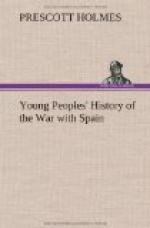These islands were discovered nearly four hundred years ago, by Magellan, as we call him in English, a famous sailor and explorer. He was the first to sail through the strait that is south of South America; and so that strait is still called by his name. After passing through that strait he led his fleet on, farther west, northwest, over the Pacific Ocean, till he came to the islands east of the China Sea. Magellan took possession of them in the name of the King of Spain; for, though not a Spaniard, he was working in the interests of Spain. He gave the islands a name, but the name did not cling to them; and some time after, they were named Islas Filipinas—or, as we say in English, Philippine Islands in honor of King Philip II., of Spain. But the savage tribes dwelling in the islands did not submit tamely to Magellan’s conquest, and in a fight with them he was killed. Still, the Spaniards held the islands, and established towns there, some of which have become very important. It is said that there are people from all parts of the world living in Manila.
Have you ever heard any one speak of the Filipinos? They are natives of the islands, descendants of the Spanish settlers; besides these there are the native savage tribes, still living in many places. The Filipinos had often tried to gain their independence, but had not been successful. When they heard of the rebellion in Cuba, they thought they would make another attempt against Spain, and so began a new rebellion. And this is just how matters stood when the war began between the United States and Spain.
The United States, having some ships in one of the ports of China, sent word to their commander, Commodore Dewey, to turn his attention to the Philippine Islands. So Commodore Dewey prepared his fleet in the best way possible and started for Manila. The ships sailed Wednesday afternoon, April 27th.
You must not think that Commodore Dewey had big battleships in his fleet. He had only what we call “cruisers,” not big battleships. The ship on which the commander of a whole fleet sails is always the “flagship.” Then, of course, each ship has its own captain and other officers. Would you like to know the names of the ships that won such fame in Manila Bay? The “flagship” was the Olympia; then there were five other cruisers: the Baltimore, the Boston, the Raleigh, the Concord, the Petrel; and a small vessel called the Hugh McCulloch. There were also two steamers carrying coal and provisions. All the fleet had been newly painted gray, to match our other vessels in this war.
During the voyage, the men were very busy getting ready for a battle, for they knew that the Spaniards had ships in Manila Bay, and that they would fire upon the new comers. Everything made of wood that might be shot and splintered, was thrown overboard; for flying splinters are very dangerous on shipboard. Tables, benches, chests, and rails were thrown into the sea. The men were told what to do in time of battle, and how to help the wounded, and the doctors arranged the rooms to be used as hospitals, so that every thing would be handy.




